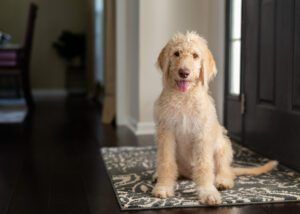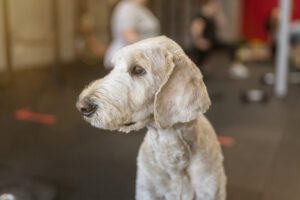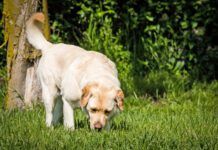
According to the Mayo Clinic, the American Academy of Allergy, Asthma, and Immunology, and the American College of Allergy, Asthma, and Immunology, no dogs are hypoallergenic. For those with serious allergies, any dogs, including hairless dogs and those who hardly ever shed, can trigger:
- Sneezing, nasal congestion, or post-nasal drip.
- Coughing, wheezing, shortness of breath, or asthma.
- Red, itchy, or watering eyes.
- Skin rash, itching, or hives.
Dramatic symptoms pose the greatest challenge, but individual responses vary and some dogs are a comfortable match for some people with allergies. It may be possible to live with the dog of your choice without struggling with breathing problems, rashes, or itching.
What does “hypoallergenic” mean?
The term hypoallergenic, which does not have a legal definition, describes foods, cosmetics, fabrics, detergents, and products that do not contain known allergens, so they are unlikely to cause allergic reactions. Dogs with little or no hair, dogs whose coats require clipping or shaving, and dogs whos are not heavy shedders are often called hypoallergenic because they may be less likely than other dogs to generate problem proteins.
The proteins that cause allergic reactions come from:
- Canine dander
- Canine saliva
- Canine urine
- Dust mites, mold spores, pollens, and other allergens that cling to a dog’s hair
Dander, made up of flaky dead skin cells, is the main culprit because it floats through the air, collects on floors and furniture, and clings to clothing. Visible dander particles look like dust or dandruff, but many are microscopic and far too small to see. Some studies show that 90% of American homes contain detectable pet allergens, and pet allergen particles circulating in a home can remain active for months.
What breeds are a better choice for people with allergies?
Dogs who shed the least and are recommended for people with allergies include the American Hairless Terrier, Chinese Crested, and other hairless breeds, plus the Afghan Hound, Airedale Terrier, Bedlington Terrier, Bichon Frise, Boston Terrier, Briard, Giant Schnauzer, Greyhound, Irish Water Spaniel, Lhasa Apso, Maltese, Poodle, Shih Tzu, Wire Fox Terrier, and Yorkshire Terrier. Their personalities, exercise needs, sizes, and training requirements vary, so focusing on low-shedding breeds is only one step in your finding-the-right-dog research project.
Which breeds are worse?
Dogs with heavy coats that collect dander and shed year-round are often blamed for allergic reactions. These “not recommended” breeds include the Basset Hound, Boxer, Cocker Spaniel, Dachshund, Dalmatian, Doberman Pinscher, German Shepherd, Golden Retriever, Labrador Retriever, Pekingese, Pug, Saint Bernard, and Siberian Husky. Because dog saliva contains allergenic proteins, the Bloodhound, Bulldog, Great Dane, Mastiff, Newfoundland, and other enthusiastic droolers can cause further reactions.
So-Called “Hypoallergenic” Breeds
During the 1950s, two of America’s most popular breeds, the Poodle and Cocker Spaniel, were combined to create the Cockapoo. Cockapoos and subsequent Poodle crosses like Goldendoodles, Labradoodles, and Bernedoodles were soon promoted as ideal family dogs and a blessing for people with allergies. Now hundreds of combinations that used to be called mutts or mixed-breeds carry impressive price tags and hypoallergenic claims.
Just because a puppy has one low-shedding parent doesn’t mean it will inherit that trait, and even if it inherits the “right” coat, it can still cause allergic reactions. The only meaningful test for people with serious allergies is in-person exposure. This is why allergists recommend visits to animal shelters, breeders, and foster homes as well as trial adoptions to determine whether direct contact with a specific breed or specific dog will trigger allergy symptoms.
Housekeeping Advice for Dog-Allergic Dog Owners
There are many people who are allergic to dogs but love them too much to consider not sharing their home with one or more. Using extraordinary housekeeping techniques will reduce the accumulation and circulation of dog-source allergens in a home.
- Use a professional pet dander removal cleaning service.
- Install and maintain HEPA (High Efficiency Particulate Air) filters.
- Dust, damp-mop, and vacuum daily with a vacuum cleaner designed for pet hair.
- Wash dog beds, blankets, toys, and dog garments using laundry products labeled hypoallergenic or fragrance-free.
- Whenever needed, steam-clean carpets, rugs, and upholstered furniture.
- Regularly deep-clean walls, floors, curtains, shelves, woodwork, and anywhere dander might cling.
- Try Ecology Works anti-allergen solutions or Allersearch environmental allergy control cleaners to minimize household allergens.
- Urine contains allergenic proteins, so neutralize fresh or dried stains with Bubba’s Stain and Odor Terminator, Nature’s Miracle Urine Destroyer, or a similar enzyme pet stain cleaner.
- Create an “allergy-free” (meaning “dog-free”) zone to minimize dander in that part of the house.
Grooming Dogs Who Live With Allergic People
For families with allergies, no dog is maintenance-free. They all require daily brushing and frequent bathing. The more time your dog spends outdoors, the more you’ll be exposed to pollen, dust, mold spores, and allergenic debris from other dogs. Some allergic owners rely on professional groomers for routine clipping, shaving, bathing, or coat conditioning, which can be expensive. Hypoallergenic dog grooming involves equipment (brushes, combs, clippers, scissors, towels, and hair dryers), supplies (hypoallergenic dog shampoos, conditioners, or anti-dander products), and time. The time investment can be substantial, so be sure the necessary grooming routines are comfortable for you and your dog. At a minimum:
- Brush your dog daily, preferably outdoors.
- Wash your hands after grooming or touching your dog.
- Place your clothes in the washer after grooming your dog.
- Bathe your dog as often as needed to prevent dander using hypoallergenic shampoos and conditioners (dilute products before use and rinse thoroughly).
- Use grooming wipes between baths.
- Try grooming sprays that remove dander between baths, such as Allerpet or Nature’s Miracle Dander Remover.
Does your dog have allergies?

Your allergies may be only part of the problem. Your dog might have allergies, too. The most common symptoms of canine allergies are itching, scratching, and skin or coat dander, exactly what you don’t need more of!
Allergies usually appear in adult dogs, not puppies, and most dogs are between two and six years old when diagnosed. Common causes of allergic reactions include flea or mite bites, exposure to environmental or seasonal allergens, exposure to products that contain irritating or harmful ingredients, and reactions to certain foods. If you suspect that your dog has allergies, schedule an exam with your veterinarian to determine causes and treatments.
Anti-allergy dog blankets and bedding, which help repel mites and mold spores and which do not contain irritating chemicals, may help an itching dog.
What foods and supplements reduce dog dander?
Nutrition plays a key role in maintaining a healthy coat. A simple way to improve your dog’s diet and help decrease shedding and dander is by increasing the diet’s animal protein content (see “10 Healthy Additions to Your Dog’s Dry-Food Diet”). Foods and supplements that contain Omega-3 fatty acids, such as fish oils, can improve a dog’s skin. Digestive supplements that improve the assimilation of nutrients further reduce skin flaking and dander.
When it’s worth the effort
The 100% truly hypoallergenic dog is indeed a myth, but there is much dog lovers can do to make their pets less allergenic. Not everyone with allergies will find a perfect health-match companion, but by focusing on conditions they can control, many allergy sufferers live comfortably with the dogs they love.





